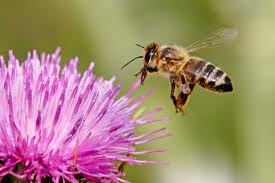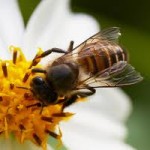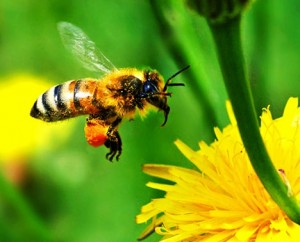 It is believed that bees originally evolved from hunting wasps which acquired a taste for nectar and become vegetarians. Fossil evidence is limited but bees probably appeared on the planet about the same time as flowering plants in the Cretaceous period, 146 to 74 million years ago.
It is believed that bees originally evolved from hunting wasps which acquired a taste for nectar and become vegetarians. Fossil evidence is limited but bees probably appeared on the planet about the same time as flowering plants in the Cretaceous period, 146 to 74 million years ago.
Bees of all kinds belong to the order of insects known as Hymenoptera, which is made up of some 100,000 species and includes wasps, ants and sawflies. Of the 20,000 plus known species of bees, the majority are solitary bees most of which lay their eggs in specially constructed tunnels.
Honeybees belong to the family of social bees which includes bumble bees and the tropical stingless bees of the genus Meliponinae. These social bees nest in colonies headed by a single fertile female, the queen, which is generally the only egg layer in the colony. Foraging for nectar and other tasks such as feeding the queen and the larvae, cleaning brood cells and removing debris, are carried out by a caste of females, called the worker bees. Honey and pollen is stored and larvae are reared in cells made from wax secreted by the worker bees.
The sub-family Apinae or honeybees, comprises a single genus, Apis, which is characterised by the building of vertical combs of hexagonal cells constructed bilaterally from a mid point using only wax secreted by the worker bees. The cells are multi functional, being used repeatedly for rearing the larvae and for the storage of honey and pollen.
Two attributes of honeybees which have been essential to their evolution and biology are their clustering behaviour and particularly in the case of the cavity-nesting species, their ability to cool the nest by evaporation of water collected from outside. These two attributes allow the colonies to regulate the temperature within their nest irrespective of the external temperature. By doing this the genus Apis was able to colonise a wide variety of environments, ranging from tropical to cool temperate. Unlike the Meliponinae which lack this capability and are confined to tropical regions.
Another behavioural character of honeybees is the communication of information about food sources between colony members. This sophisticated communication concerning direction and distance of pollen, nectar and water sources allows them to efficiently exploit their environment.
Whereas representatives of most types of bee were indigenous to all the continents, bees belonging to the genus Apis were originally to be found only in the Asia, Africa and Europe. The genus Apis comprises four species: Apis florea, the Little Honeybee, Apis dorsata , the Giant Honeybee, Apis cerana , the Eastern Honeybee and Apis mellifera , the Western Honeybee. Some writers also include Apis laboriosa and Apis andreniformis as separate species, but it is likely that these are geographical subspecies of Apis dorsata and Apis florea respectively, although they do show greater physical variations than the other subspecies and in fact are possibly in a more advanced stage of species development.
Apis dorsata and Apis florea build single comb nests in the open, the former preferring low bushes and the latter trees. Although unsuitable for modern beekeeping use, both these species make a major contribution to the supply of honey and wax in the countries that they are found in.
The lifestyle of Apis cerana is similar to that of the Western Honeybees and like Apis mellifera it is used in apiculture with modern moveable comb hives. The numerical strength of Cerana colonies is usually much less than for Mellifera and honey yields are also smaller. It is therefore being rapidly supplanted by imported Mellifera races, chiefly Apis. m. ligustica (Italian Honey Bee).
However bees of the genus Apis are not the only bees which contribute to the World’s supply of honey and wax. Some species of Meliponinae form very large colonies and store sufficient honey to make exploitation worthwhile. Tribes of Central and South American Indians have kept these bees in some form of man-made structure for hundreds of years.
 Origins of the Honey Bee
Fossils of the true Apis type have been discovered dating back to 22 to 25 million years ago in what is now Western Germany.
Origins of the Honey Bee
Fossils of the true Apis type have been discovered dating back to 22 to 25 million years ago in what is now Western Germany.
 Development of Sub-species of Genus Apis
The development of colony clustering and the use of closed nests, usually in cavities, allowed some species to occupy cooler temperate zones and this is believed to have occurred in Southern Asia, possibly in the Himalayan region
.
Development of Sub-species of Genus Apis
The development of colony clustering and the use of closed nests, usually in cavities, allowed some species to occupy cooler temperate zones and this is believed to have occurred in Southern Asia, possibly in the Himalayan region
.

